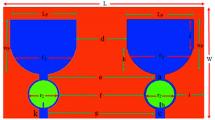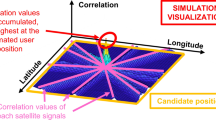Abstract
The channel capacity of a relay cooperative system with Maximum Ratio Combining (MRC) in a realistic indoor ultra-wideband communication is investigated by ray-tracing technique and Asynchronous Particle Swarm Optimization (APSO). We deploy amplify-and-forward relay to enhance the magnitude of signal and the propagation distance for a library indoor environment. When the transmitter is set in the center of this library environment without using relay, the outage probability of channel capacity is 49 %. The outage probabilities can be reduced to 18 % by using MRC of the cooperative relay, when the transmitter and relay are fixed in the center of the right half part and left half part respectively. Moreover, APSO is employed to search the best locations of the transmit antenna and relay antenna for reducing the outage probability. The outage probability can be reduced to zero by APSO algorithm in the numerical results.








Similar content being viewed by others
References
Federal Communications Commission (2002). Revision of Part 15 of the commission’s rules regarding ultra-wideband transmission system, first report and order, FCC, ET Docket, Feb 14, 2002, pp. 1–118.
Liu, Q., Zhang, W., Ma, X., & Zhou, G. T. (2012). Designing peak power constrained amplify-and-forward relay networks with cooperative diversity. IEEE Transactions on Wireless Communications, 11(5), 1733–1743.
Ngo, H. Q., Quek, T. Q. S., & Shin, H. (2010). Amplify-and-forward two-way relay networks: error exponents and resource allocation. IEEE Transactions on Communications, 58(9), 2653–2666.
Yang, K., Yang, J., Jinsong, W., Xing, C., & Zhou, Y. (2014). Performance analysis of DF cooperative diversity system with OSTBC over spatially correlated Nakagami-m Fading channels. IEEE Transactions on Vehicular Technology, 63(3), 1270–1281.
Haghighat, J., & Hamouda, W. (2012). Decode-compress-and-forward with selective-cooperation for relay networks. IEEE Communications Letters, 16(3), 378–381.
Shin, H., & Song, J. B. (2008). MRC analysis of cooperative diversity with fixed-gain relays in Nakagami-m Fading channels. IEEE Transactions on Wireless Communications, 7(6), 2069–2074.
Laneman, J. N., Tse, D. N. C., & Gregory, W. (2004). Cooperative diversity in wireless networks: efficient protocols and outage behavior. IEEE Transactions on Information Theory, 50(12), 3062–3080.
Chen, M., Serbetli, S., & Yener, A. (2008). Distributed power allocation strategies for parallel relay networks. IEEE Transactions on Wireless Communications, 7(2), 552–561.
Ma, Y., Liu, A., Hua, Y. (2014). A dual-phase power allocation scheme for multicarrier relay system with direct link. IEEE Transactions on Signal Processing, 62(1):5–16.
Avendi, M. R., & Nguyen, H. H. (2013). Selection combining for differential amplify-and-forward relaying over rayleigh-fading channels. IEEE Signal Processing Letters, 20(3), 277–280.
Kim, J.-B., & Kim, D. (2010). Performance of dual-hop amplify-and-forward beamforming and its equivalent systems in rayleigh fading channels. IEEE Transactions on Communications, 58(3), 729–732.
Ikki, S. S., & Ahmed, M. H. (2009). Performance of cooperative diversity using Equal Gain Combining (EGC) over Nakagami-m fading channels. IEEE Transactions on Communications, 8(2), 557–562.
Zhao, Y., Hao, Y., Alomainy, A., & Parini, C. (2006) UWB on-body radio channel modeling using ray theory and sub-band FDTD method. IEEE Transactions on Microwave Theory and Techniques, Special Issue on Ultra-Wideband, 54(2), Part 2, 1827–1835.
Huang, C. H., Chen, C. H., Chiu, C. C., & Li, C. L. (2010). Reconstruction of the buried homogenous dielectric cylinder by FDTD and Asynchronous Particle Swarm Optimization. Applied Computational Electromagnetics Society Journal, 25(8), 672–681.
Kennedy, J., & Eberhart, R. Particle Swarm Optimization. In Proceedings of the 1995 IEEE international conference on neural networks, pp. 1942–1948.
Chiu, C. C., Ho, M. H., & Liao, S. H. (2013). PSO and APSO for optimizing coverage in indoor UWB communication system. International Journal of RF and Microwave Computer-Aided Engineering, 23(3), 300–308.
Author information
Authors and Affiliations
Corresponding author
Rights and permissions
About this article
Cite this article
Cheng, YT., Chiu, CC. Optimization of the Antenna Location for Relay Cooperative System by APSO. Wireless Pers Commun 83, 2485–2495 (2015). https://doi.org/10.1007/s11277-015-2541-9
Published:
Issue Date:
DOI: https://doi.org/10.1007/s11277-015-2541-9




